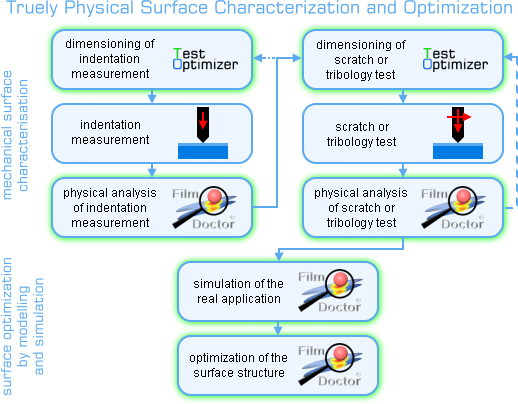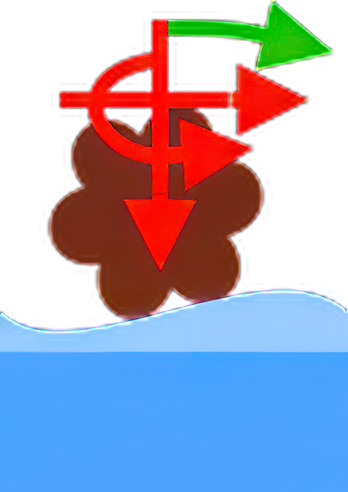FilmDoctor® is the ultimate software for physical characterization, engineering, and optimization of arbitrary structured surfaces! It enables you not only to exactly dimension but also physically evaluate surface or contact measurements in order to mechanically characterize the surfaces. This is absolutely necessary for engineering or optimization of any surface by means of physical modeling and simulation. Of course, FilmDoctor® is equipped with such functionalities as well. Thus, FilmDoctor® allows you to cut time-consuming and costly testing for coating engineering or optimization on the one hand and to increase the certainty of your durability prediction significantly on the other hand.

Features
The features covered below are features of the model on which this product series is based. Therefore, they may differ from the capabilities of the individual editions as they are not all completely implemented in all editions.
Supported Material Structures
The software allows you both to analyze the following surface structures among others by evaluating mechanical contact measurements, and to model them for simulation purposes:
- multi-layer coatings (up to 100 layers)
- thin films (theoretically down to 1 angstroem*)
- thick films (theoretically unlimited*)
- with intrinsic/thermal stresses and gradients of it (functional)
- laminate structures
- composites
- nano-particle-enhanced coatings (nanotubes, fullerenes, …)
- inclusions and defects not only within layers but also at interfaces
- superlattice
- homogeneous monolithic bulk materials (e.g. substrate only)

Supported Contact or Load Conditions
Among others, the following conditions and effects can be taken into account not only for the evaluation of mechanical surface measurements, but also for the modeling of complex load or contact situations of the real application by our software:
- multi-axial loads (normal, lateral, and rotating loads)
- tilting and deflection of the counter part
- actual shape of the counterpart, hence also edges and asymmetries
- surface roughness, actual three-dimensional surface topography and surface curvature (e.g. from 3D pre-scan by AFM or WLI), respectively
- creep / sink-in: time-dependent material properties of viscous or visco-elastic materials (e.g. polymers)
- pile-up / residual stresses of ductile materials, plastic deformation, fractures/cracks of brittle materials
- friction between surface and counterpart
- temperature gradients / fields (e.g. necessary for high temperature applications)
- weak interfaces / poor interface adhesion

Evaluable Contact Measurements
This software enables you to analyze the following mechanical surface measurements:
- instrumented nano, micro, and macro indentation measurements and hardness tests, respectively
- multi-axial indentation measurements (with additional lateral or rotating loads)
- cyclic, dynamic, and multi-load indentations (e.g. CSM method of Agilent, QCSM method of ASMEC, ESP of Fischer)
- impact tests and drop tests
- scratch tests, adhesion tests, and scratch resistance tests
- tribology tests like wear tests and friction tests (pin-on-disc, ball-on-disc and so on)
- each also in high temperature range
- and many more
Mechanical Characterization
The most important aim of mechanical characterization is the evaluation of generic material properties, which are independent of measurement conditions (like material structure of the sample, maximum indentation depth, initial and final load, velocity etc.). Hence, it is necessary to take all these measurement conditions into account to evaluate such measurement properly. That is why we have extended the classic Oliver & Pharr method for such conditions. This Oliver & Pharr method extended for layered materials (Oliver & Pharr for Coatings) enables you to calculate – among others – the following generic material properties:
- real Young’s modulus of each layer or the substrate (elastic modulus)
- yield strength of each layer or the substrate
- Poisson’s ratio of each layer or the substrate
- intrinsic, thermal, or residual stresses of each layer or the substrate
- tensile strength
- adhesive strength
- critical stresses of all fracture modes (mode I crack, mode II crack, and mode III crack)
- layer thicknesses
Only these generic physical material properties can be reused in nearly any other surface structure (e.g. for surface optimization by means of modeling and simulation or for analysis of complex contact measurements like scratch tests) without being obliged to repeat the characterization.
This software allows you to determine the correct hardness, too. But be aware: Hardness is neither a physical nor a generic material property.
Top features
- Analysis and modeling of all available surface structures
- evaluation of non-Hertzian stress distributions
- a great variety of load and contact situations
- Evaluation of all mechanical surface or contact measurements available on the market
- Determination of important generic material properties ⇒ physical analysis
- several visualization possibilities (2D, 3D, animation, etc.)
- many modules are included like O&PfC® , SSA® , TestOptimizer® , IStress® , CritLoad Optimization® or Reference Stress®
Connection to Measurement Equipment
The following measurement equipment manufacturers already provide a direct export interface to our software, which convert measurement data directly into our format:
- Helmut Fischer GmbH (O&PfC format only)
- ASMEC GmbH – member of Zwick/Roell
- MicroMaterials Ltd. (O&PfC format only)
- Anton Paar (formerly CSM Instruments)
- Fischer-Cripps Laboratories Pty Ltd. (O&PfC format only)
Further manufacturers are still developing and will follow soon.
System Requirements
| Minimum* | Optimum | |
|---|---|---|
| operating system: | Microsoft Windows 7 | Microsoft Windows 10 or higher |
| word size: | 32 or 64 bit | 32 or 64 bit |
| CPU: | 1 cores 1 GHz | ≥ 6 cores × 2 threads ≥ 2 GHz |
| RAM: | 1 GB | ≥ 4 GB |
| free HDD space: | 50 MB (for the software) 500 MB (for project files) | 50 MB (for the software) ≥ 3 GB (for project files) |
| screen: | 1024 x 768 pixel 16 bit color depth | 1920 x 1080 pixel 32 bit color depth |
Ask us for specific consulting
Mail: info@siomec.de